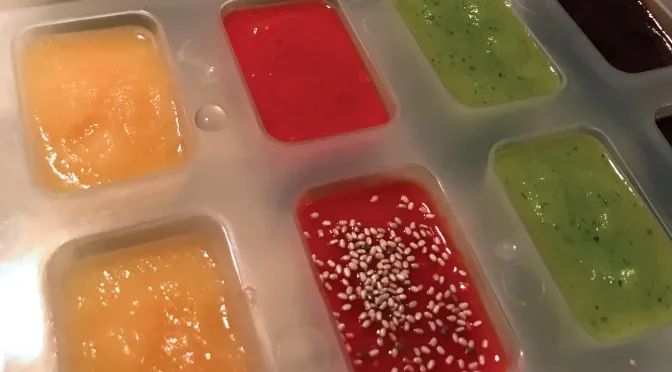
Homemade Baby Food
Starting Solids
Congratulations! Your baby is around 6 months old, and you are feeling like a pro at this breast- or bottle-feeding gig. You're starting to find a rhythm in your days, and things seem a little more predictable. Just when you feel like you’ve finally figured out exactly what your baby needs, you read an article on introducing solids, see an ad for baby food, or notice your child reaching for your dinner. What now?
The American Academy of Pediatrics and World Health Organization recommend that babies be exclusively breastfed, or formula fed, until 6 months of age. Research shows that around 6 months is when most babies’ digestive systems are mature enough to process solid foods.
Keep in mind that digestive readiness does not necessarily equate to developmental readiness. Watch your baby to determine when he or she may be ready, usually sometime between 6 to 8 months. Signs of developmental readiness are: sitting up without support, developing a “pincer” grasp, ready and willing to chew, and eager to participate in mealtime.
Homemade baby food is an excellent introduction to the world of solid foods for your little one, and easier than most people think! When getting started with solids, remember that initially, baby will still be getting all the nutrients they need from mother's milk or formula. This takes the pressure off and allows you just to have some fun and soak up every funny facial reaction and gooey mess.
Food for the Stages
STAGE 1: Simple Purees
Start with purees or mashes of one whole food only, so that if your child has a reaction, you'll be able to pinpoint the root of the problem accurately. Vegetables and fruits are ideal for purees, so you’ll need a steamer pot and high-speed blender to create your concoctions.
Tips: Add filtered water or, more ideally, pumped breastmilk to blend foods to the right consistency. Make in a large batch, freeze in ice cube trays, and pop out small portions to thaw as needed.
Purees we love: Roasted winter squash, sweet potatoes, yams, or carrots / Steamed apple, pear, spinach, zucchini, or frozen peas / Raw blended berries / Raw mashed avocados or bananas
STAGE 2: Blends
Now that you've observed baby's reaction to lots of different foods start experimenting with blended purees. Get creative with combinations, even if it doesn't sound pleasant to your adult palate. This is an excellent time to introduce homemade broths (vegetable or bone broths), spices, and some grains and seeds (oats, chia seeds, flax).
Tips: Remember that fruits are sugary, and these early stages are forming baby’s palate. Try mixing leafy greens with sweet fruits to bring balance.
Blends we love: Carrot turmeric & bone broth / Strawberry basil spinach / Cinnamon & ginger sweet potato with flax / Broccoli pea & pear / Raspberry kale & chia
STAGE 3: Small Bites & Allergens
Baby is chewing well and has done great handling less allergenic foods. Start cutting soft foods into small bites for baby to practice picking up and eating on his or her own. You can also begin to introduce foods that are common allergens.
Tips: Be sure to keep a close eye on baby as they try more solid pieces, as there is an increased choking hazard. Feed common allergenic foods to baby earlier in the day so that you can monitor any potential reactions before bedtime.
Small bites we love: Bitesize chunks of roasted sweet potato or carrot/ banana or avocado / very ripe peaches, pears or plums / meat or poultry / soft-cooked green beans
Common allergens we love for Stage 3: Dairy (plain Greek yogurt), wheat (soft bread or pasta), eggs (scrambled), seafood (boneless fish), nuts (peanut, cashew, and almond butter)
STAGE 4: Anything Goes
Baby handles chewing like a champ and has no known allergies. Start to give baby what everyone else is having for dinner, making adjustments as needed. For example, baby cannot handle spinach salad, so you finely chop spinach and sprinkle it on the mashed potatoes.
Tips: Keep an eye out for choking hazards (whole grapes, raw carrots) and transform into something baby can handle (chop smaller, steam or cook to soften).
Meals we love: Whatever mom and dad are having!
about the author...Anna Rogers is a transplant from the Carolinas with a background in marketing and graphic communications. She is a wife and mother who loves to garden, cook, and practice yoga. Anna is passionate about travel, which at its core is really a passion for people, as she believes people and community are what truly bring life and beauty into a place.
Originally printed in the pages of Simply Family Magazine’s January 2019 issue.
Check out the digital edition, here!
